 Men and children gather around the Bimah in an exuberant celebration of being Jewish. (Jonah Light)
Men and children gather around the Bimah in an exuberant celebration of being Jewish. (Jonah Light)
To read David Suissa’s column on The Happy Minyan, click here.
In his book “Tzava’at Harivash,” Rabbi Israel Baal Shem Tov, the founder of Hasidic Judaism, writes: “Serve God with reverence and with happiness. They are two companions, complementing one another, that must never part.”
This is a teaching that The Happy Minyan in Pico-Robertson takes to heart. On any given Shabbat or Jewish holiday, members sing at the top of their lungs, excitedly dance around the bimah and daven with absolute joy. Close your eyes at one of their services, and you might just think you’re at the Kotel during peak Shabbat davening.
This is intentional. The Happy Minyan is a Modern-Hasidic synagogue that takes the teachings and melodies of Rabbi Shlomo Carlebach zt”l, using them to infuse passion into prayer and soulfulness into spirituality.
“You’re singing, dancing, eating, sharing with others and enjoying prayer. There really is a sense that you are not just observing Shabbos – you are celebrating it.” – David Sacks
“At The Happy Minyan, prayer is a participatory sport,” said David Sacks, one of the co-founders. “You’re singing, dancing, eating, sharing with others and enjoying prayer. There really is a sense that you are not just observing Shabbos – you are celebrating it.”
After operating out of the Rokah Karate studio on Pico Boulevard for many years and holding services in members’ backyards during COVID, Happy Minyan has finally secured a space of its own at 9311 West Pico Blvd. This is a momentous step for the synagogue, which, since its founding, has never had a permanent home.
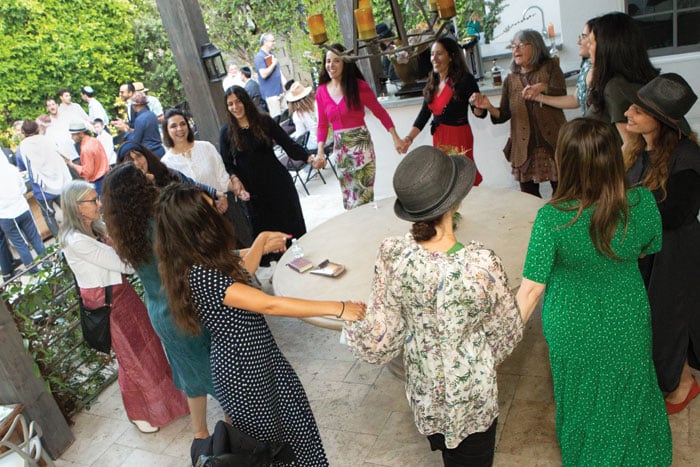
“This will be the first time ever that The Happy Minyan has a full-time place of its own 24/7,” said Sacks. “That means we will be able to expand the classes and programming we do. We really want it to be a Center of Jewish Spirituality for Los Angeles, where people feel comfortable dropping by to grow and hear the beauty and positivity of what it is we’ve been yearning and working toward for thousands of years.”
In 1989, members of the Pico-Robertson community—Stuie Wax, David Sacks, Johnny Boyer, Lewis Weinger and Jeff and Linda Rohatiner— got together and decided to start a Carlebach minyan. Sacks gave the d’var Torah for the first Shabbat, and they met weekly in Wax’s home.
But the founders yearned for something more. They wanted to make Happy Minyan official, a staple for the neighborhood that everyone could enjoy. In 1995, they moved into the basement of Beth Jacob Congregation in Pico-Robertson, and it was then that the name Happy Minyan came about.
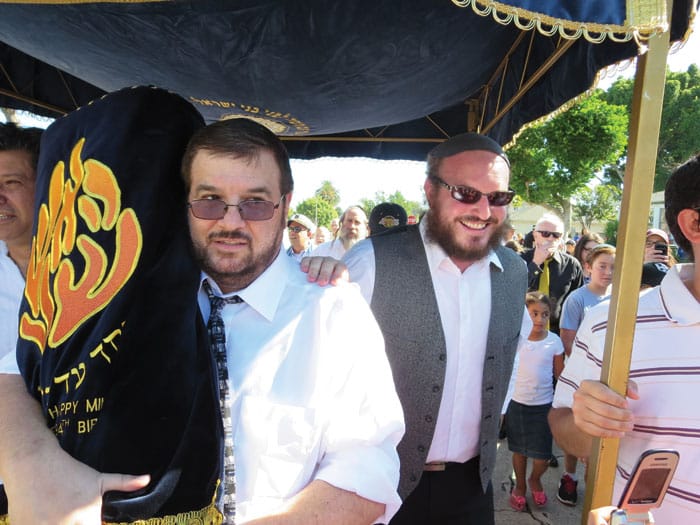
The synagogue started attracting Jews from all different backgrounds, from those who were frum from birth (FFB) to baal teshuvas, from Hasids to secular Jews and men and women and children of all ages.
Naomi Solomon, executive director of The Happy Minyan, whose husband Yehuda Solomon is the chazzan and lead singer of Moshav band, started attending services in 1999 because of the upbeat davening she experienced there.
“Most people go to shul either because as an observant Jew, davening with a minyan is required, or because it’s a place where they can connect socially and identify with being Jewish,” she said. “Happy Minyan is a place where people actually embrace and enjoy davening. Meaningful davening, like yoga or a meditation practice, becomes something that people crave. [They’re] waiting all week to be back in shul on Shabbos so they can plug back in to that joy and connection.”
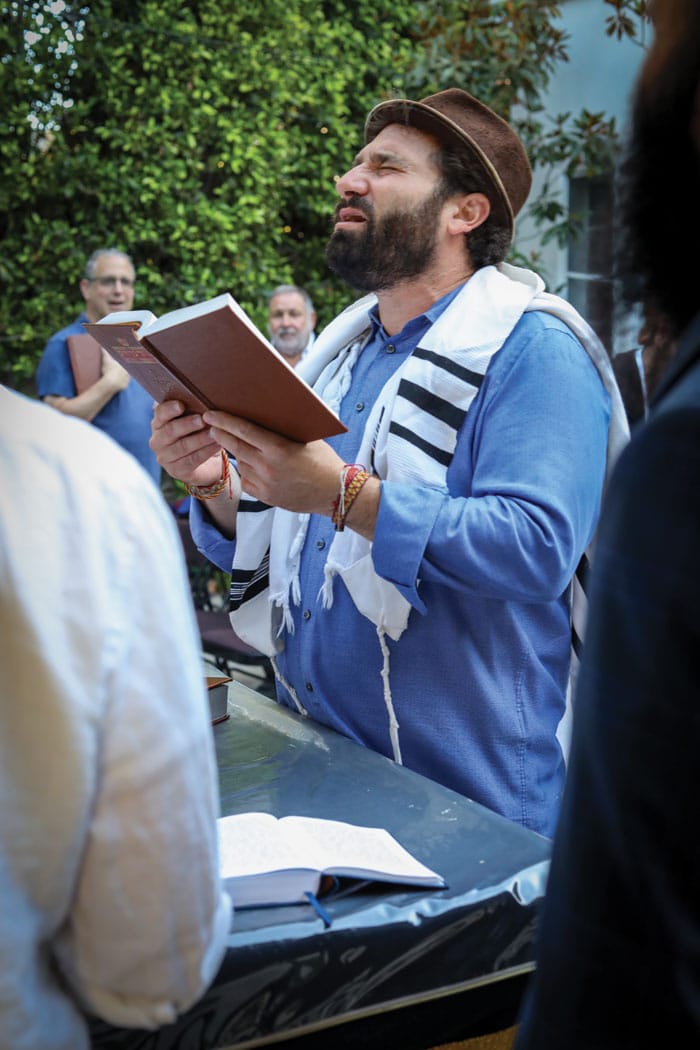
The synagogue offers a Sunday morning class, other classes and concerts year round, weekly Shabbat services, a monthly sponsored Shabbat lunch for the community and childcare for ages 6 months to 12 years during services.
“Even our children look forward to coming with us to shul, not to participate in the children’s program, but to actually be in shul, davening,” said Naomi. “Two of our children go early, at 8:30 a.m., 30 minutes before davening begins to hear David Sacks’ Shabbos morning shiur. I think that speaks worlds about what it’s like for children growing up at Happy Minyan.”
The minyan currently has about 100 members, and visitors from around the world – New York, Chile, Israel and Northern California, to name a few – come to pray there. When Sacks, an Emmy Award-winning producer and writer for “The Simpsons” and “Malcolm in the Middle,” was in Mea Shearim in Jerusalem, he was making small talk with a Hasid who was selling tallit bags when the topic of his shul came up.
Sacks told the Hasid he goes to The Happy Minyan, and the Hasid got so excited that he called across the store to another Hasidic man who was working the cash register, telling him, “This person davens at The Happy Minyan in Los Angeles.”
“His friend was even happier,” Sacks said. “Meanwhile, I was trying to figure out what was going on. I ask, ‘Have you been there?’ And the person said, ‘No. But I know that at The Happy Minyan every Jew is welcome.’ It was a great moment realizing that what we’ve created with the atmosphere at The Happy Minyan has become bigger than the place itself.”
Though the Minyan has developed a reputation around the world, and more people have been attending services at the tail end of COVID, that doesn’t mean the pandemic was easy for the shul to navigate.
“Our COVID experience could be compared to a forest fire. We were stripped down to the core… But on the other side of that long haul of survival, when we finally regenerated, we came back even stronger.” – Naomi Solomon
“Our COVID experience could be compared to a forest fire,” said Naomi. “We were stripped down to the core. We lost our space, left most of our belongings behind, stopped serving food and ended our childcare program. Everything was so uncertain and there were times when we had hardly more than a minyan. But on the other side of that long haul of survival, when we finally regenerated, we came back even stronger.”

In typical Happy Minyan spirit, members stepped up to offer their backyards as part of a grassroots operation. For months, services were held in the backyards of couples Bryna and Moishe Fiedler, Travis and Nikita Putnam and Ruchie and Steve Fried.
“Something magical happened when we began praying in the home of the Frieds,” Naomi said. “When the first month ended, they extended. After the second month ended, they extended again. After the third month, they said we could stay at their home indefinitely until we were able to move back indoors.”
The synagogue has been in that backyard for 11 months; when the new space on Pico is ready – hopefully before the High Holidays – it will move.
With the backyard davening, The Happy Minyan proves that a spiritual connection can happen anywhere. The Frieds have an olive tree in their yard that doesn’t bear fruit; the gardener chose it so it wouldn’t make a mess. After several months of holding services there, with Yehuda Solomon singing under the tree, the tree now has olives.
“The barren tree is bearing fruit,” said Naomi. “[That’s] the power of prayer.”
Ask any Happy Minyan member to describe the shul, and one word will keep popping up: welcoming.
“Happy Minyan offers a safe and joyous space for anyone, no matter where they are holding spiritually, or how they dress, to come and connect through joy, and get a taste of Shabbes,” said Yehuda Solomon. “Once you pray with Happy Minyan, you never leave.”
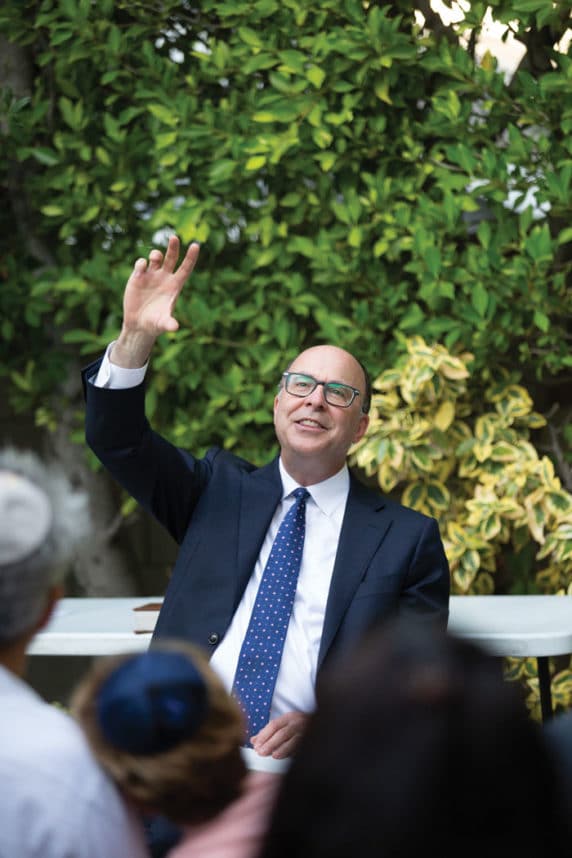
(Jonah Light)
Sacks, a baal teshuva (returnee to Torah observance), didn’t keep Shabbos or kosher growing up, but his mom did start taking him to a synagogue when he was 14. That “little shul across the street” from his home, he said, was the Carlebach Shul on 79th and West End Avenue, which has been around since the 1940s.
“Reb Shlomo brought me to Torah observance, was like a father to me, and married me and my wife,” said Sacks. “Going there created a yearning in me that finally culminated in becoming observant when I was 24.”
Yehuda also had a personal connection with Carlebach. He grew up in Israel on Moshav Mevo Modi’in, next door to the rabbi. His parents had met Carlebach in San Francisco at The House of Love and Prayer, a synagogue the rabbi founded, in the early ‘70s. There, they reconnected with their Judaism.
Yehuda’s father ended up being a founder of Diaspora Yeshiva Band, which performed some of Carlebach’s tunes. The chazzan followed in his father’s footsteps, founding a Jewish band of his own, Moshav, which was also influenced by Carlebach.
The synagogue is not only for those who were close to Carlebach; it is for anyone who wants to feel a deeper spiritual connection. Although some members grew up observant, they find the services at Happy Minyan help them connect on an even deeper level.
“After I started going to Happy, I found myself counting down the days until Shabbos so I could feel that amazing connection to Hashem that I feel every Friday night and Shabbos day at Happy.” – Bryna Fiedler
“I used to find Shabbos really difficult, [because powering] down from work and [being] shut off from the world was really hard,” said Bryna Fiedler, who has been a member for six years. “After I started going to Happy, I found myself counting down the days until Shabbos so I could feel that amazing connection to Hashem that I feel every Friday night and Shabbos day at Happy. That connection helped me realize that the whole week is the hard part and Shabbos is pure joy and peace.”
David Fiedler, Bryna’s husband, who was also frum from birth, had a similar experience.
“Like many of my FFB peers, I never went to shul on Friday nights, but then when I came to minyan on Friday night over six years ago, I was hooked,” he said. “My wife, high school and middle school children love it too. We even bring Shabbat in early every Friday, and it is the highlight of our week.”
Another favorite for members is the High Holidays, and specifically Yom Kippur, which takes on a whole new meeting at the synagogue. Services last longer, the singing is extra meaningful and they reach new spiritual highs.
“The level of intention and focus brought forth as a united community, combined with such heartfelt awe and joy for the potential of the day results in an extremely powerful and moving spiritual experience that is unmatched by any other day of the year,” said Naomi. “It’s simply awesome.”
According to Naomi, in signing the long-term lease at the new space, The Happy Minyan now has a permanent place for Shabbat and holiday services. They will be launching open-book learning for men, chavruta-style, hosting women’s drop-in morning davening after carpool, reopening for seudah shlishit on Shabbat, the third meal, and extending it into a melaveh malkah after Shabbat ends.
“Having our own space allows for the organic process of the Minyan’s growth and the opportunity to fully access our potential.” – Naomi Solomon
“Having our own space allows for the organic process of the Minyan’s growth and the opportunity to fully access our potential,” Naomi said.
Nikita Putman, a member for six years who attends services with her family, is looking forward to gathering in the new space.
“I hope the space will result in more access to not just praying over Shabbat, but [also] learning and enriching all aspects of Jewish life,” she said. “It is a space where people can come and feel like an extended family.”
It is their goal, as always, to help Jews, no matter where they’re coming from, connect to their yiddishkeit, their community and their Creator, of course, with joy.
The Happy Minyan community is optimistic about their synagogue’s future. It is their goal, as always, to help Jews, no matter where they’re coming from, connect to their yiddishkeit, their community and their Creator, of course, with joy.
“We are excited to further engage the youth and for them to know that they will have a place on Pico they can call their own,” said Naomi. “Having our own dedicated space means more concerts, more gatherings and more Torah learning. We’ve been dreaming of this for years and now, with God’s help, it’s finally here.”
The Happy Minyan’s capital campaign, “Mission Possible” will launch online August 9th. Tax-deductible donations can be made anytime at happyminyan.org/donate. To become a campaign ambassador, please email info@happyminyan.org.
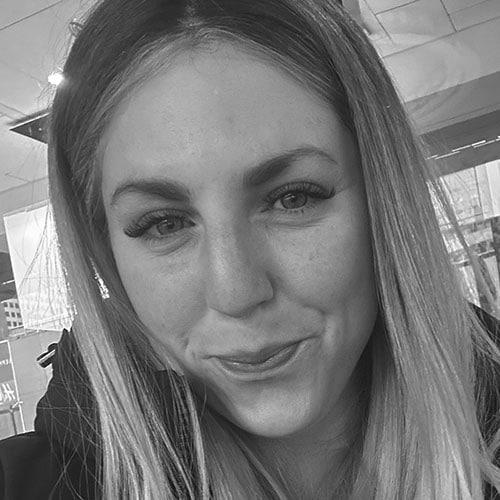






















 More news and opinions than at a Shabbat dinner, right in your inbox.
More news and opinions than at a Shabbat dinner, right in your inbox.